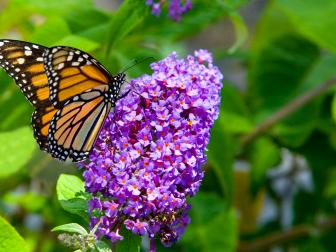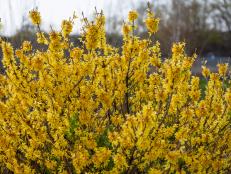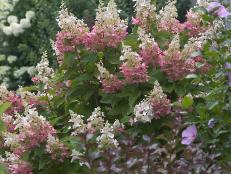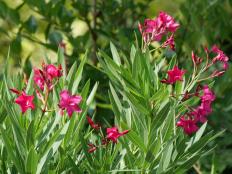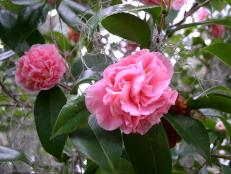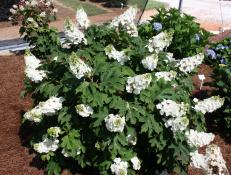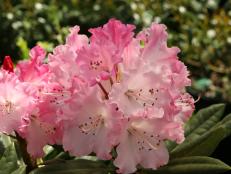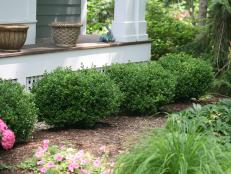Growing Spirea
Looking for an easy-to-grow shrub? Try spirea. This versatile beauty blends good looks with a tough-as-nails personality.

ProvenWinners.com
Double Play Big Bang Japanese spirea
Spirea shrubs add timeless beauty to a landscape. Botanically known as Spiraea, this plant is popular for its long flowering window and fuss-free nature. Spirea bushes bloom in spring or summer, opening blossoms in shades of pink, red, mauve or white. The flowers beckon pollinators like butterflies and bees.
Butterfly Garden Flowers 26 Photos
These vibrant flowers and plants provide nectar for butterflies and create a bold border for your yard.
Spirea bushes can grow anywhere from 2 to 10 feet tall and wide. They're very fast growers, with some selections adding up to 2 feet of new stems in a growing season. Spirea plants are hardy in Zones 3 to 9, depending on the type. This dependable shrub tolerates many different growing conditions, including poor soil, drought, heat, humidity and urban pollution.
Botanical Name: Spiraea spp
Common Name: Spirea
Hardiness Zones: 3 to 9
Size: 2 to 10 feet tall and wide
Bloom Time: Spring or summer
Bloom Colors: Shades of pink, red, mauve or white
Some common types of spirea bushes include bridal wreath spirea and Japanese spirea (Spiraea japonica), which offers a host of varieties, including 'Goldmound' spirea, 'Little Princess' spirea and Magic Carpet spirea (Spiraea 'Walbuma').

Julie Martens Forney
Bridal wreath spirea
If you're looking for a versatile shrub that's basically bulletproof, spirea definitely fits the bill. Learn what you need to know to grow spirea plants successfully.
Planting Spirea
When to Plant
In most regions, fall is the ideal time for planting a spirea bush. In regions with frost, get plants in the ground at least six weeks prior to your zone's first average frost date. You can also plant in spring. Just be sure to remember to water spring-planted spireas when summer heat arrives.
Where to Plant
Choose a spot for your spirea bush that's sunny — plants should receive at least four to six hours of sun each day. Spirea bushes, especially the spring flowering ones, will tolerate light shade. In general, though, spirea plants in shade tend to have fewer flowers and less vibrant autumn colors.

ProvenWinners.com
Double Play Gold Japanese spirea
Well-draining soil helps a spirea bush thrive. If you have clay soil, it's a good idea to add organic matter, such as compost or composted manure, to help that dense soil drain better. Spirea plants don't grow well in soggy soil.
Growing Spirea
Watering
Once a spirea bush is established in the landscape, it boasts some drought tolerance and can usually survive on regular rainfall. During excessively hot, dry episodes, though, it's a good idea to water spirea plants occasionally. For new spirea plants, water regularly during the first growing season (once a week unless there's an inch of rainfall), until plants have started growing new stems and leaves.
In coastal areas, spireas are a good landscape plant but can suffer damage from summer heat and drought. Add a 2- to 3-inch-thick mulch layer in the dripline area beneath the shrub to help soil retain moisture.
Mulching
Once each year, mulch beneath your spirea plant to help maintain soil moisture and suppress weeds. Use an organic mulch, such as triple shredded bark, pine needles, fir bark fines or whatever is locally available in your region. Apply a 2- to 3-inch-thick layer.
Feeding
If you prepared your soil prior to planting by amending with organic matter and mulching annually, a spirea bush usually needs very little to no extra fertilizer. If you want to feed your spirea plant, use a slow-release fertilizer for trees and shrubs that's applied at the start of the growing season. Follow instructions on the package. Take care not to overfertilize spirea as that causes the plant to produce long, floppy stems that sprawl.
Pruning
Because spirea bushes grow so quickly, you'll need to prune regularly to keep plants looking and growing their best. The right time to prune is immediately after flowering. Prune to shape the plants as needed and to increase air flow into the center of the shrub. Cut out the oldest, woodiest stems every few years to spur new, vigorous stems. Remove dead or damaged branches at any time during the growing season.
For spring bloomers like bridal wreath spirea, 'Snowmound' spirea or Mellow Yellow spirea (Spiraea thunbergii 'Ogon'), prune within a week or two after the flower show finishes. Typically, these spirea varieties don't need much — if any —pruning. Take care to choose the right size spirea variety for your planting spot so you won't need to do major pruning to keep the shrubs in bounds.
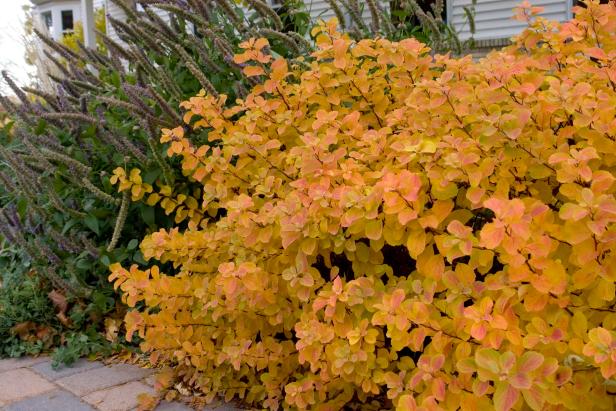
BaileyNurseries.com
‘Tor’ birchleaf spirea
For summer blooming spirea bushes, including 'Goldmound' spirea, 'Anthony Waterer' spirea and Japanese spirea (Spiraea japonica), plan to prune in winter or early spring. Prune to shape the plant. To reduce an overgrown spirea bush's size, cut plants back to about 6 inches tall before growth starts in spring. It's also good to lightly prune summer-flowering spirea bushes after they bloom. Cut to remove the spent flowers and a few inches of stems. The plant may experience another flush of bloom later in the season.
Types of Spirea Plants
- Bridal wreath spirea (Spiraea prunifolia) — One of the largest spireas, this plant grows 4-8 feet tall and 6-8 feet wide. Stems arch to create a fountain effect. Bridal wreath spirea makes a stunning sight in full bloom in spring when white flowers cover branches. Use as a hedge. Hardy in Zones 5-9.
- Japanese spirea (Spiraea japonica) — Many varieties of this spirea are available with flowers in shades of white, rose red, light pink or purple. Some have blue-green leaves; others have gold foliage. Size and hardiness vary by cultivar. Common ones include 'Goldmound' spirea, Magic Carpet spirea, 'Little Princess' spirea and Double Play spireas.
- 'Anthony Waterer' spirea (Spiraea x bumalda) — Rosy pink flowers open on a low-growing plant that needs less pruning. Plants grow 3-5 feet tall and wide. Hardy in Zones 4-9.
- Birchleaf spirea (Spiraea betulifolia) — Small, rounded type that grows 3-4 feet tall and wide. White flowers in summer, but the real show is the fall color, with leaves in shades of red, orange and purple. Zones 3-9.
- Blue Mist spirea (Caryopteris clandonensis) — Not a true spirea. Also known as bluebeard. In late summer, plants open blue flowers that pollinators can't resist. Tolerates drought, heat and humidity. Grows 1-3 feet tall by 3-6 feet wide. Hardy in Zones 5-9.
Spirea FAQs
Is spirea a good shrub for a pollinator garden?
Yes, spirea flowers are a favorite of butterflies, bees, flower flies and other pollinators.
Does spirea stay green through winter?
All spirea plants lose their leaves in winter, even in the warmest zones.
Do deer eat spirea plants?
Typically, deer ignore most spirea plants, but they will eat them on occasion. The plant breeders who developed Double Play Doozie spirea report that those plants are deer- and rabbit-resistant.
Is spirea invasive?
Some spirea plants spread aggressively by seed in certain regions. Check with your local extension office to learn what spirea bushes might be a problem in your area. Newer spirea varieties, such as Double Play Doozie spirea, were developed by plant breeders to be seedless and non-invasive.
In the garden, Japanese spirea stems root where they touch soil. When pruning, use care to gather all clippings or you might end up with a crop of young spirea bushes.







